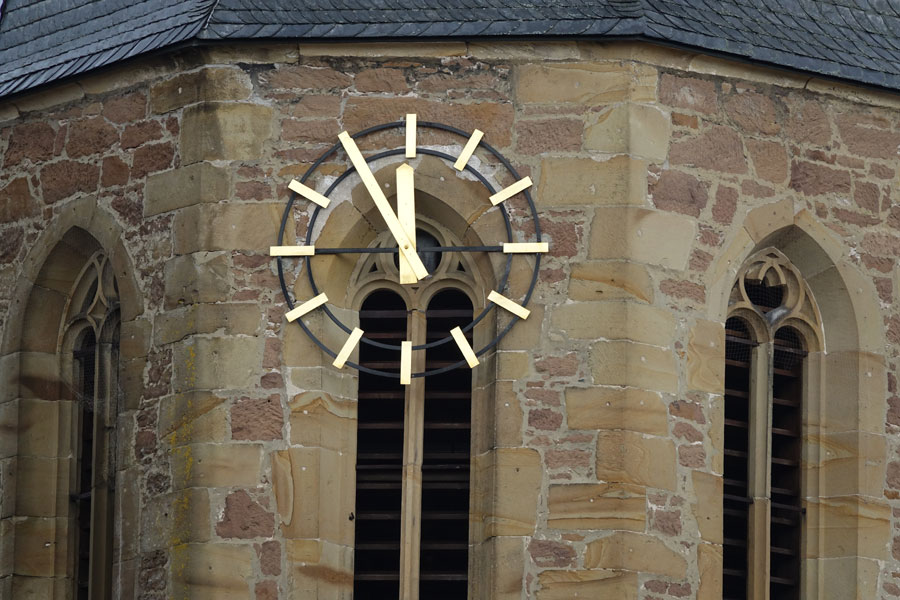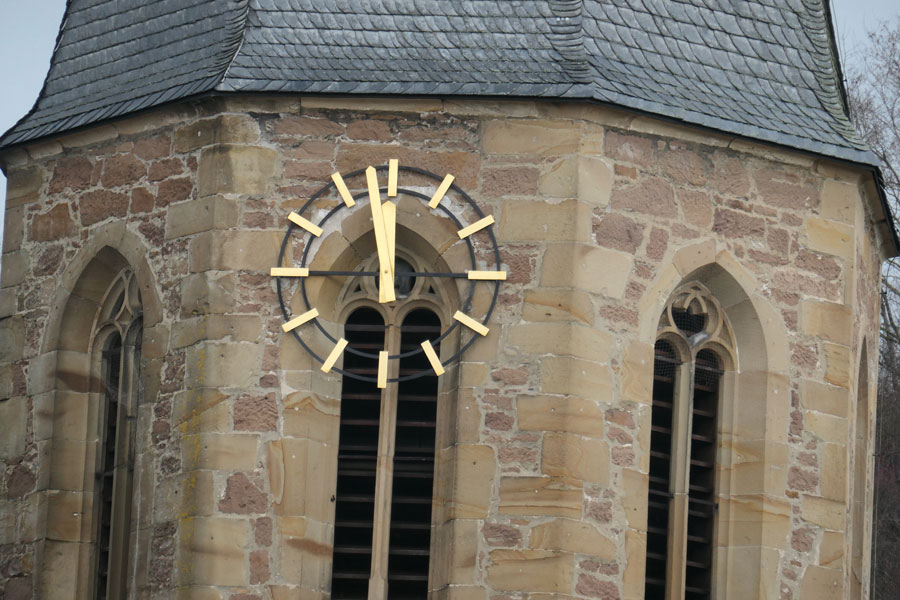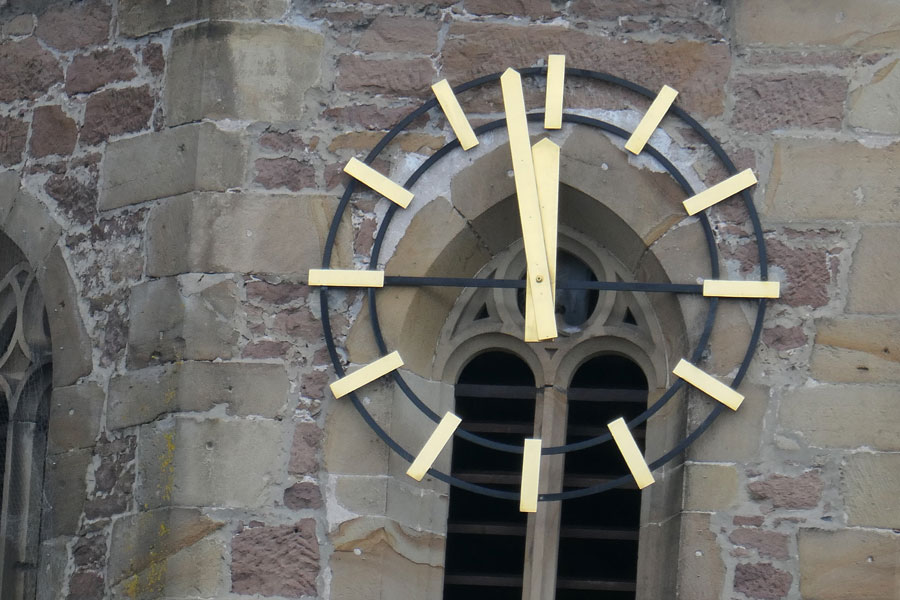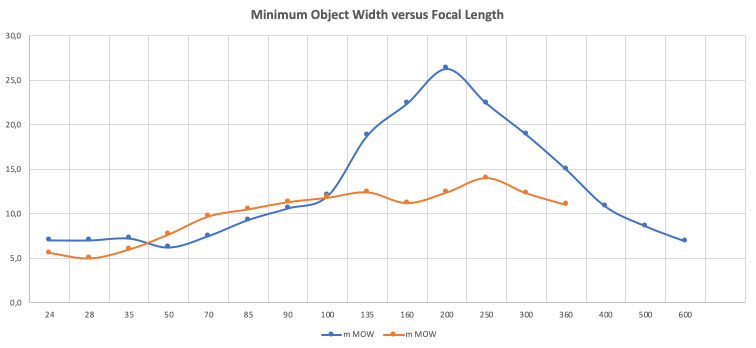Panasonic TZ202: Comparison with Sony RX10 M3
Introduction | The Lens | Size and Weight Comparisons | Sample Photos (References) | References
On this page, I try to compare two cameras that are very different and, on the other hand, similar: the Sony RX10 M3 and the Panasonic TZ202. I bought both cameras with the intention to have more zoom range with an 1" sensor camera as well as a camera that I can use for shooting close-ups with a telephoto lens from a larger distance. Typical objects are butterflies that fly away if you get too close...
Introduction
The Sony RX10 M3 and the Panasonic TZ202 are two very different cameras that, by chance, share an 1" sensor (not the same one...). Comparing these cameras may not do justice either one. Nevertheless, I provide some comparison data here, because I bought both cameras for a similar purpose, namely for taking close-ups, particularly telephoto close-ups.
I bought the Sony RX10 M3 after I had used the Panasonic TZ202 for more than half a year and on three vacations, but felt that I was not content with the camera in some respects, particularly when taking photos of butterflies farther away. On the TZ202, the digital zoom would achieve a sufficient magnification (at 720 mm equiv.), but the results disappointed me (grainy). So I mused whether a camera with a 600 mm optical zoom, as the Sony RX10 M3 offers, might do the trick - and bought one fairly spontaneously at the end of 2018... Actually, taking close-ups with a focal length of 600 mm may not be for everyone, for quite a number of reasons. Only experience will show, whether I will be happy with this...
On this page, I focus more or less on the lenses. For size and weight comparisons and data, see below.
The Lens
The lens was for both cameras my main argument for buying it. Therefore, it will play a prominent role in my comparison.
For opinions on the lenses of both cameras, see pages Sony RX100: Lens and Panasonic TZ202: Lens
Technical Data
| Data | Sony RX10 M3 | Panasonic TZ202 | Comment |
| Lens | Carl Zeiss® Vario-Sonnar T* 8.8-220 mm (24-600 mm equiv.) f/2.4-f/4 18 elements in 13 groups (6 aspheric elements, including AA lens) |
Leica DC Vario-Elmar 8.8-132 mm (24-360 mm equiv.) f/3.3-f/6.4 13 elements in 11 groups |
Sony: The same lens is used in the RX10 model 4. |
| Zoom | Optical Zoom: 25 x
Clear (Image) Zoom: 20 MP approx. 50 x / 10 MP approx. 70 x / 5 MP approx. 100 x / VGA approx. 380 x Digital Zoom: up to 100 x |
Optical Zoom:15 x Intelligent Zoom: up to 2 x (= 30 x) Digital Zoom: up to 4x (= 60 x) |
Sony: There are two types of digital zoom: Clear (Image) Zoom (higher
quality, lower range), and Digital Zoom (lower quality, wider range) Panasonic: There are two types of digital zoom: Intelligent Zoom (higher quality, lower range), and Digital Zoom (lower quality, wider range) - to be refined |
| Filter diameter | 72 mm | None | Panasonic: No possibility for attaching adapters... |
| Aperture range | From 2.4 to 16 in 1/3 EV increments | From f/3.3 to f/8 (wide angle) / f/6.4 to f/8 (telephoto) | Both: Maximum aperture depends on focal length. |
| Distance setting range (from front lens) | AF (W: Approx. 3 cm to infinity, T: Approx. 72 cm (28.35") to infinity; at fl = 250 mm (equiv.): 140 cm (55.12") to infinity | AF (W: 50 cm to Infinity, T: 1 m to Infinity) AF Macro (W: 3 cm to Infinity, T: 1 m to Infinity) |
Sony: Distances are measured from the lens (as advertised
by Sony); the camera provides larger values (measured from the focal plane) Panasonic: Distances given by camera |
| Smallest object field | Approx. 72 x 48 millimeters at wide angle and long end (my own measurement) => 0.18 = 1:5.5 | 56 x 37 / 50 x 33 mm at maximum wide angle (24/28 mm) => 0.236 = 1:4.24; 109 x 73 mm at the telephoto end (360 mm) | My own measurements |
Some Personal Remarks on the Lenses
The Panasonic TZ202's lens is the lens with the widest focal range for a compact 1" sensor camera (24-360 mm equiv. = zoom range 15 x), whereas the one of the Sony RX10 M3/4 the lens with the widest range of any 1" sensor camera (24-600 mm equiv. = zoom range 25 x) at this date (January 2019). And this is, probably, where the commonalities between both lenses end... The two photos below demonstrate that the two lenses are very different beasts:
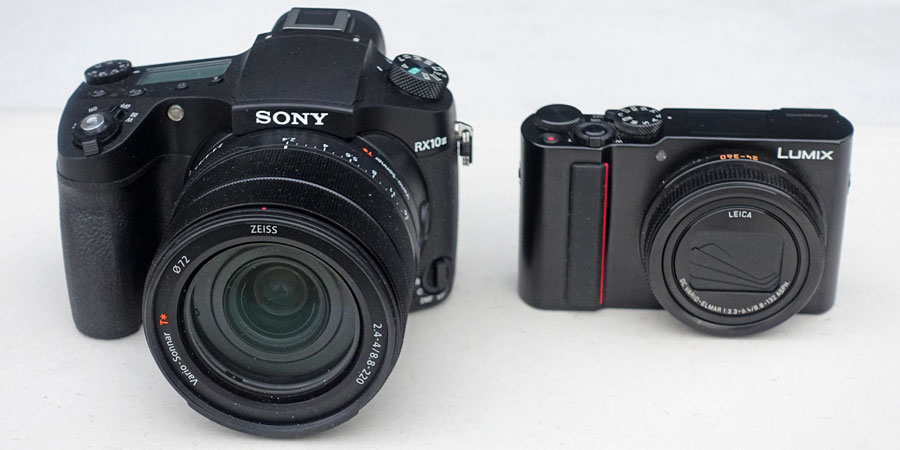 |
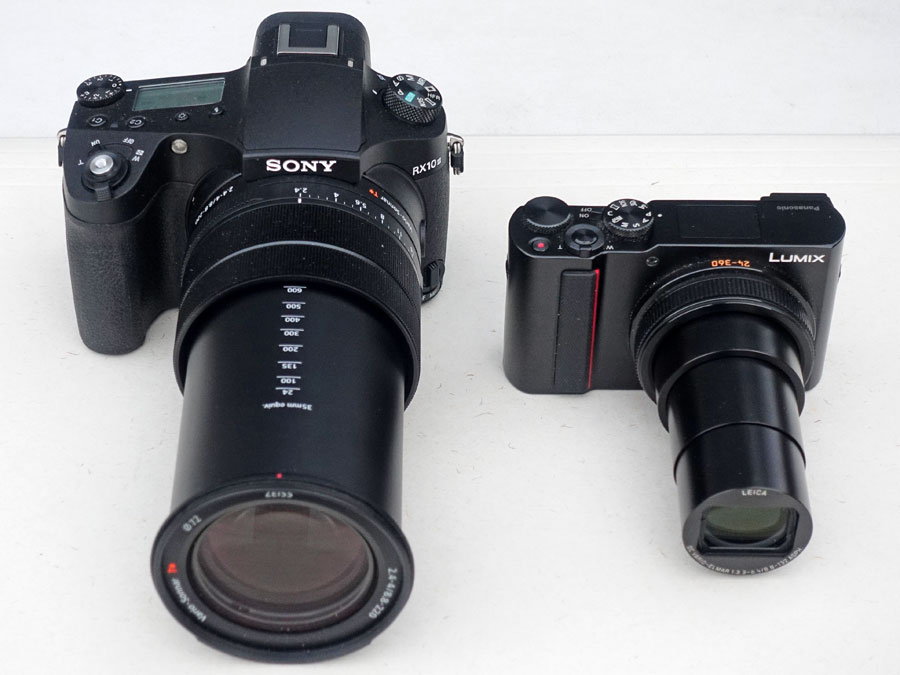 |
|
Oblique front view, off (RX10 M3 to the left) |
Oblique front view, 600 and 360 mm (RX10 M3 to the left) |
The huge Sony RX10 M3 lens is considerably faster across the zoom range (f/2.4-4) than the one of the Panasonic TZ202 (f/3.3-6.4), which also extends quite a bit, allowing you to play around with aperture even at longer focal lengths. The RX10 M3 is limited to f/4 starting with a focal length of 100 mm, the TZ202 gets there already between 35 and 50 mm. Above 200 mm, the TZ202's maximum aperture lies beyond f/6, and since its aperture range already ends at f/8, this leaves very little room for changing aperture and playing around with depth of field. At least, the TZ202 offers an ND filter for the case that the sun is too bright, whereas the RX10 M3 does not (in both cases, you may want to switch to the electronic shutter or let the camera decide automatically which shutter type to use).
Since, depending on your point of view, fuzziness caused by diffraction may already become noticeable at f/6.4*, the "soft" lens of the TZ202 (as most reviewers tell us...) also fights with diffraction at the long end (there is a "diffraction compensation" setting, but the manual warns of artifacts...). So I am a little bit "uneasy" with the technical concept of the TZ202's lens...
*) I discuss this topic on page General: Calculating the Optimum Aperture for Different Sensor Sizes (Diffraction Limit), and there state that diffraction gets visible for 1" cameras at f/8, but other people may feel that it already starts at larger apertures (actually, it does; the relevant question is, however, from which aperture value on diffraction visibly limits a lens' sharpness).
With respect to close-up shots, both cameras seem to be good choices. The TZ202 gets even a little bit closer, whereas the RX10 M3 excels at the long end. But shooting close-up at long focal lengths is not easy. You have to fight camera shake and "unwilling movements," that is, you have to use short shutter speeds (and thus, to increase ISO if it is too dark), may have problems with finding your photographic objects, and also with maintaining the optimal section for your motif (because you move around quickly...). Thus, taking close-ups at long focal lengths may not be the right thing for you... In the end, I decided for the RX10 M3 because of the "extra bit" that it offers at the telephoto end, but only experience will show, whether I will be happy with shooting close-ups at 600 mm...
Note: For opinions on the lenses of both cameras, see pages Sony RX100: Lens and Panasonic TZ202: Lens
Zoom and Digital Zoom
The following comparison photos demonstrate the extreme ends of the lenses of both, the Sony RX10 M3 and the Panasonic TZ202, including the focal lengths that can be achieved with higher quality digital zoom (Clear Image Zoom or i.Zoom). For the Sony RX10 M3, I also show samples taken at a focal length of 400 mm for a comparison with the 360 mm achievable with the optional zoom of the TZ202.
Minimum Object Width and Zoom
Neither Sony nor Panasonic disclose the maximum possible magnification for their cameras in macro mode. I took test shots to find out the minimum object width (which I find more useful than magnifications values) for both cameras. I consolidated these numbers a little bit to be able to create diagrams from them (table to the left). Both diagrams (to the right) show my mean minimum object width values across the focal length scale.
Do not take all this too seriously, but a few things can be easily read from these diagrams.
- Below a focal length of 50 mm (equiv.), the Panasonic TZ202 magnifies more, at nearly 50 mm, both cameras seem to perform about the same, and at 50 mm, the RX10 M3 is in the lead.
- Between 50 and 90 mm, the Sony RX10 M3 magnifies more, around 90 to 100 mm, both cameras seem to perform about the same again.
- From 100 mm up to the maximum focal length of the TZ202, which is 360 mm, the TZ202 is in the lead again.
- At about 400 mm, the Sony takes the lead, because the Panasonic does not offer focal lengths longer than 360 mm, and starts at about the same magnification, where the TZ202 leaves at 360 mm.
- Between 100 mm and 400 mm, the Sony RX10 M3 is not really "competitive" with respect to close-up photos (but it is not much worse than our two Sony RX100 models).
A few more remarks:
- The RX10 M3 lens has its "sweet spots" for close-up shots at 50 mm and 600 mm, the TZ202 lens at 28 mm, 160 mm, and 360 mm (with nearly the same magnification at 360 mm as at 160 mm).
- The minimum object width that the RX10 M3 can achieve is a little more than 6 cm at 50 mm; above 400 mm, the minimum object width decreases from nearly 11 cm to nearly 7 cm.
- The minimum object width filling a frame that the TZ202 can achieve are
about 5 cm at 28 mm; at 160 and 360 mm, the minimum object width decreases
to 11 cm, that is, to the same value that the RX10 M3 achieves at 400 mm
(and around 90 to 100 mm).
Note, however, that beyond 400 mm, minimum object width decreases to 7 cm at 600 mm for the RX10 M3. Thus, beyond the focal lengths that the TZ202 can offer, the RX10 M3 really shines.
The close-up behavior of the Sony RX10 M3 between the focal lengths of 100 to nearly 400 mm is odd to say the least. It seems to reflect the complexity of the lens. Usually, it is not a problem to magnify less, but for interior shots, the magnification at 400 mm may be too much at 1 m distance while you cannot step back to use a minimum distance between 1.2 and 1.5 m as is required for focal lengths between 200 mm and a little less than 400 mm. Perhaps focal lengths between less than 160 mm and 70-85 mm can help you out here and close the gap...
Notes:
- For more information see also page Close-up Comparison with Panasonic TZ202/Sony RX10 M3 (the link leads to the RX10 M3 section)
- See also the same page (the link leads to the RX10 M3 section) for a close-up comparison where the Sony RX10 M3 is used with a +3 achromat.
Size and Weight Comparisons
Size and weight-wise, the Sony RX10 M3 and the Panasonic TZ202 are very different beasts that seem to share an 1" sensor by chance... Despite its huge zoom range, the TZ202 is a still pocketeable camera, albeit not as tiny as the Sony RX100 models. But this size increase is welcome for me, the TZ202 handles much better than my Sony RX100 M4. The RX10 M3, on the other hand rivals DSLRs and system cameras in size and weight. It is nearly as if you put a super zoom lens on such a camera - and probably the RX10 M3 is a little big lighter and smaller than such a combination would be (but to my knowledge, such a zoom lens currently does not exist...).
Sony RX10 M3 and Panasonic TZ202
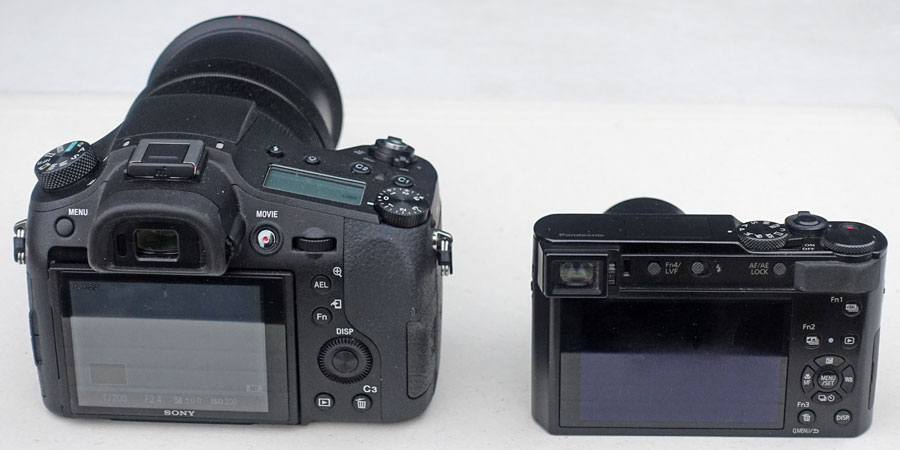 |
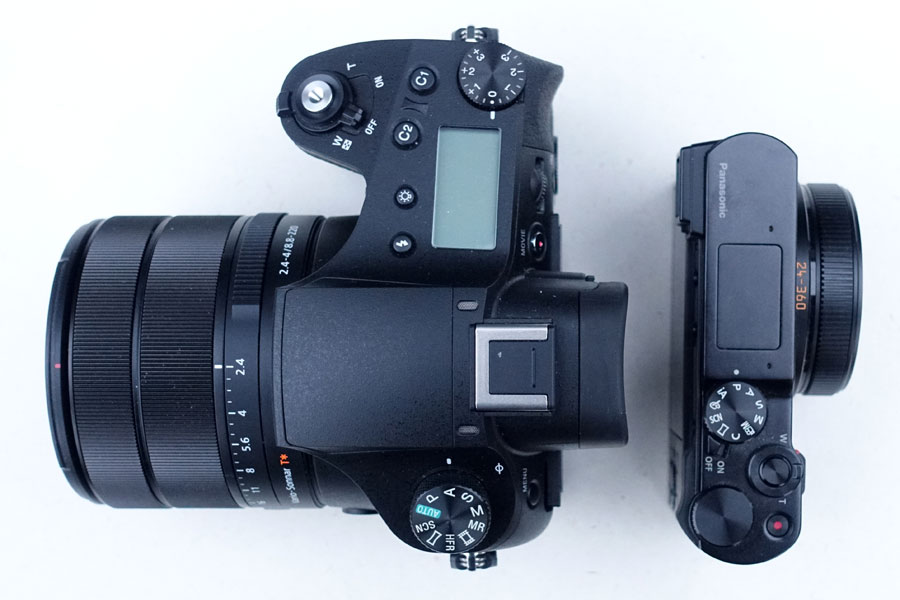 |
|
Rear view, off (RX10 M3 to the left) |
Top view, off (RX10 M3 to the left) |
|
 |
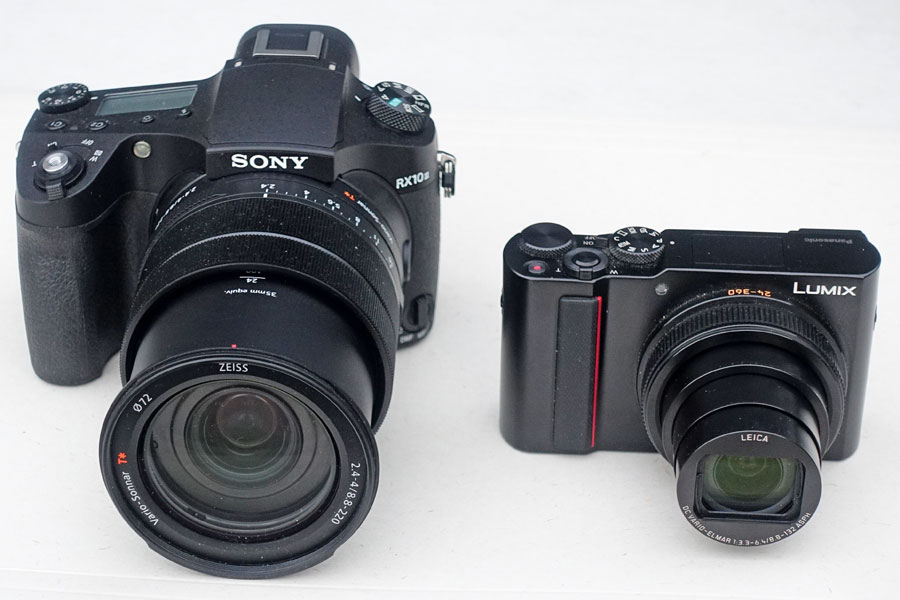 |
|
Oblique front view, off (RX10 M3 to the left) |
Oblique front view, on (RX10 M3 to the left) |
|
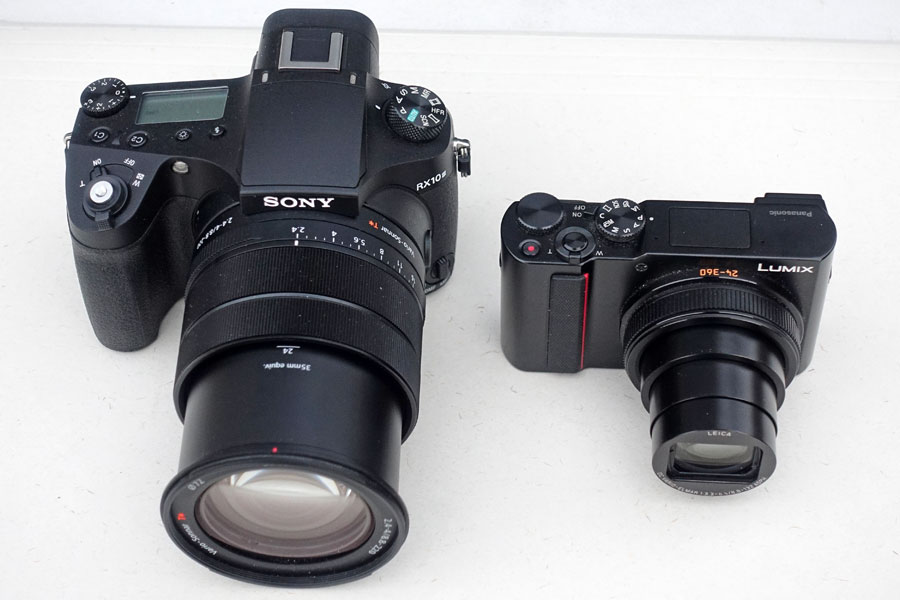 |
 |
|
Oblique front view, 24 mm (RX10 M3 to the left) |
Oblique front view, 600 and 360 mm (RX10 M3 to the left) |
|
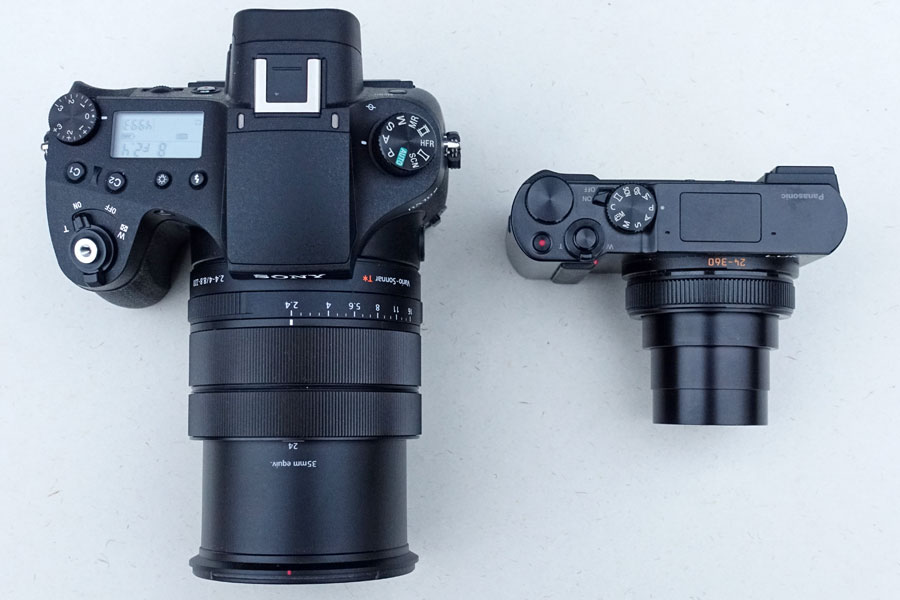 |
 |
|
Top view, 24 mm (RX10 M3 to the left) |
Top view, 600 and 360 mm (RX10 M3 to the left) |
Sony RX10 M3, Panasonic TZ202, and Sony RX100 M4
I also included my smallest camera, the Sony RX100 M4 in the comparison...
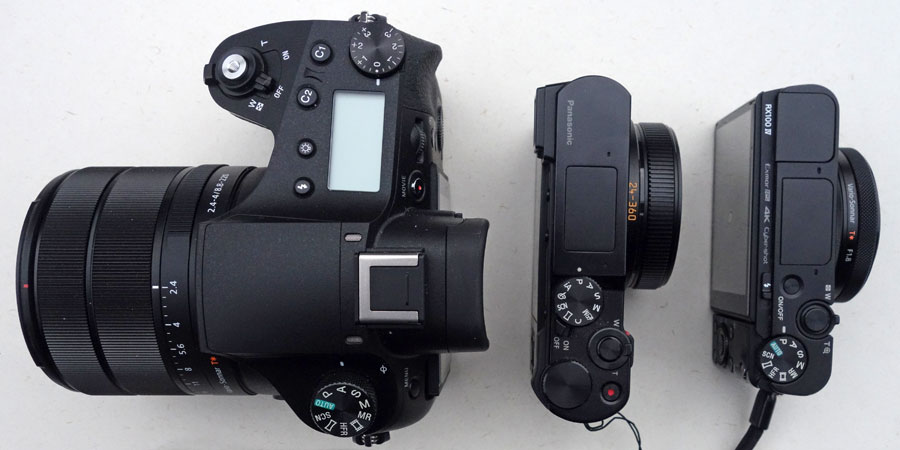 |
 |
|
Top view (RX10 M3, TZ202, RX100 M4) |
Rear view (RX10 M3, TZ202, RX100 M4) |
|
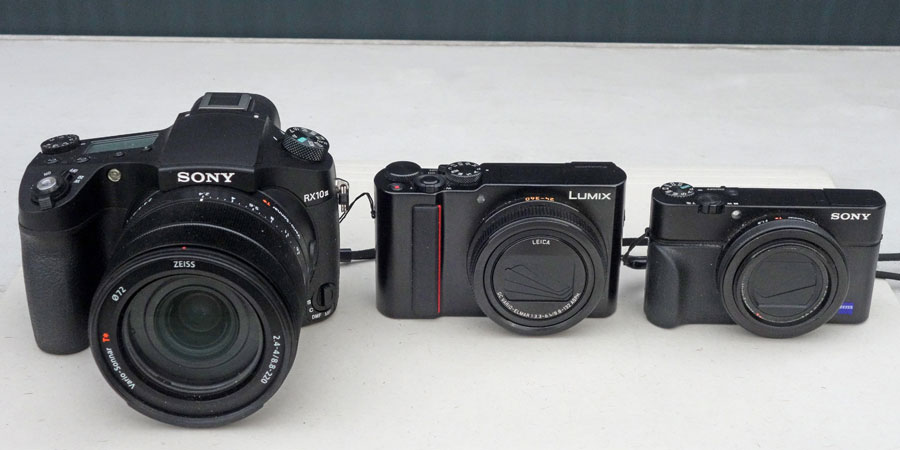 |
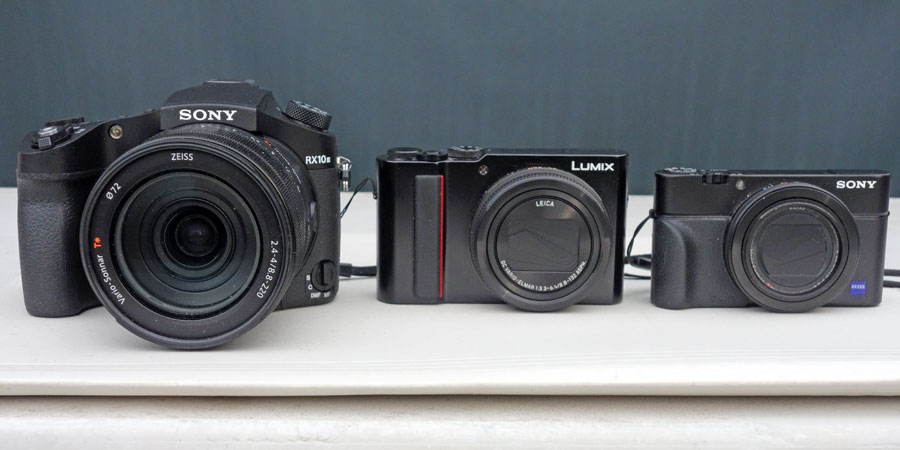 |
|
Front view (RX10 M3, TZ202, RX100 M4) |
Front view (RX10 M3, TZ202, RX100 M4) |
In Numbers...
| Sony RX10 M3 | Panasonic TZ202 | Sony RX100 M4 | |
| Dimensions | 132.5 x 94.0 x 145.0 mm, 132.5 x 94.0 x 127.4 (from front of lens to monitor) / 5 1/4 x 3 3/4 x 5 3/4", 5 1/4 x 3 3/4 x 5 1/8" (from front of lens to monitor) (W x H x D) | 111 x 66 x 45 mm / 4.37 x 2.6 x 1.77" (W x H x D) | 101.6 x 58.1 x 41.0 mm / 4 x 2.29 x 1.61 in (W x H x D) |
| Weight | Approx. 1051 g (2 lb 5.1 US oz.), with accessories approx. 1095 g (2 lb 6.7 US oz.) | Approx. 298 g, with accessories approx. 340 g | Approx. 271 g (9.56 US oz.), with accessories approx. 298 g (10.51 US oz.) |
I also included my smallest camera, the Sony RX100 M4 in the comparison...
Viewfinder
Here are the technical data for the viewfinder of three of my cameras:
- Panasonic TZ202: 2,330,000 dots / 0.53 x magnification
- Sony RX100 M4: 0.39-type electronic viewfinder (OLED) / 2,359,296 dots / 0.59 x magnification
- Sony RX10 M3: 0.39-type electronic viewfinder (XGA OLED) / 2,359,296 dots / 0.7 x magnification
So, they all have the same resolution, but a different magnification. The Panasonic TZ202 viewfinder pleases me the least. It offer the smallest view, the view looks fairly dull and often somewhat fuzzy. The Sony RX100 M4 viewfinder has nice colors, I do not see the pixels, but the view still appears a little too small to me, particularly when focusing manually. The Sony RX10 M3 offers the largest viewfinder magnification, has somewhat different colors than the RX100 M4, and I can already discern pixels. But that does not disturb me - size matters more for me. The look through the RX10 M3 viewfinder somewhat reminds me of a DSLR, mostly because of the image size.
Althouth the magnification factors do not differ that much if you just look at the numbers, they make a huge difference for me when I look through these viewfinders. On the other hand, all of them are usable for manual focusing when I use screen magnification (partially or whole) and focus peaking. And the TZ202 has the nicest feel when I turn the lens ring for focusing...
Sample Photos (References)
Sample photos made with the two cameras can be found on the pages listed below.
Sony RX10 M3
Panasonic TZ202
References
Sony RX10 M3
See page Sony RM10 M3 Links
Panasonic TZ202
See page Panasonic TZ202 Links
| 08.02.2019 |


